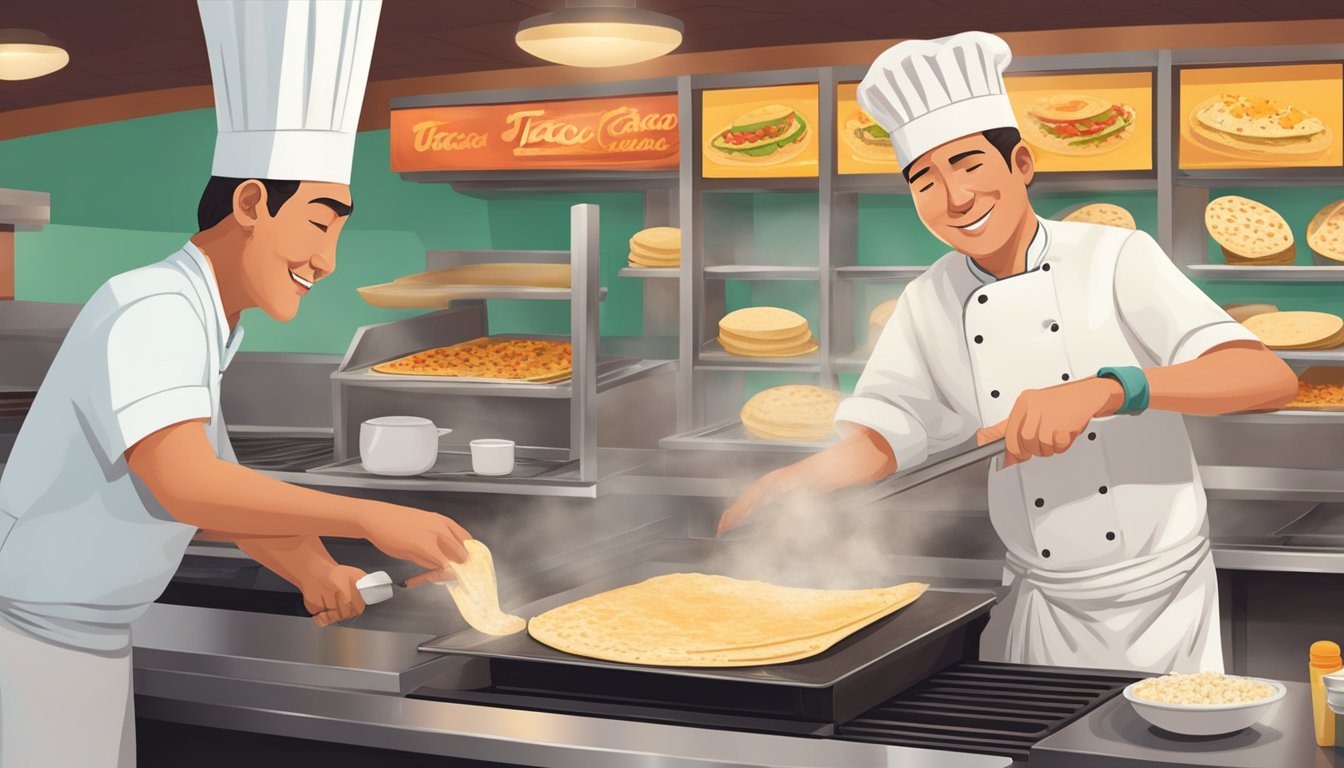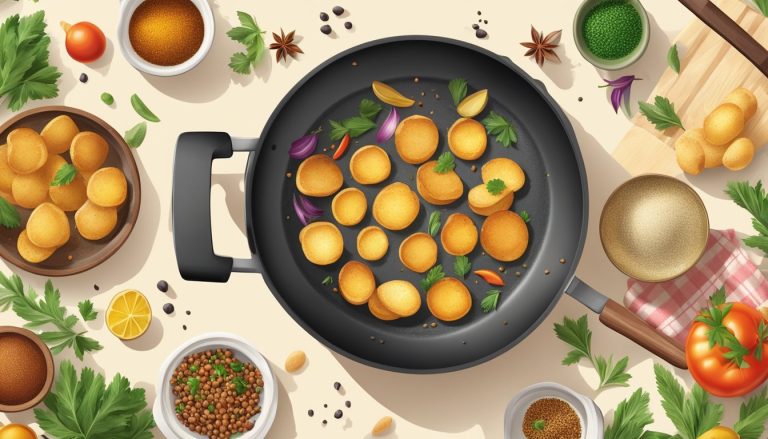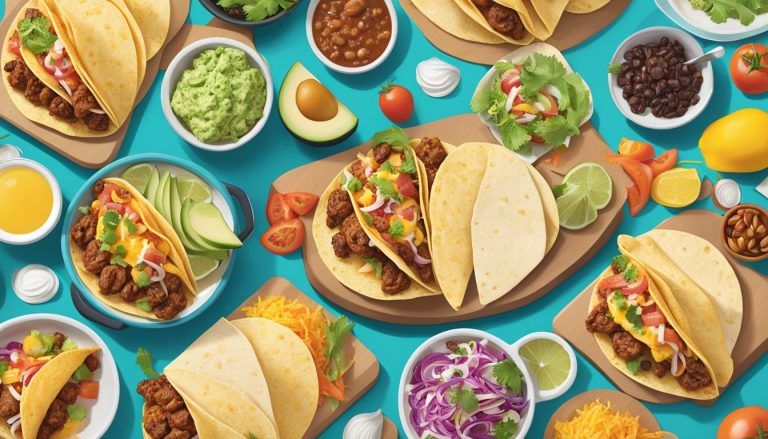Taco Cabana has been delighting Tex-Mex enthusiasts since 1978 with its signature fresh-made flour tortillas. These pillowy discs of perfection are the foundation of many of the restaurant’s beloved menu items. Taco Cabana’s commitment to crafting tortillas in-house sets them apart from many fast-casual competitors.
The art of creating the perfect flour tortilla at Taco Cabana involves a careful balance of ingredients and technique. Each tortilla is made fresh throughout the day, ensuring customers always receive a warm, pliable wrapper for their tacos, fajitas, and quesadillas. This dedication to quality has helped Taco Cabana maintain its popularity for over four decades.
Visitors to Taco Cabana can watch as skilled staff members press and grill tortillas right before their eyes. The aroma of freshly cooked flour tortillas wafts through the air, enticing customers and adding to the authentic Tex-Mex experience. This commitment to freshness and quality has made Taco Cabana’s tortillas a standout feature of the brand.
The History and Evolution of Flour Tortillas
Flour tortillas originated in northern Mexico and later gained popularity in Tex-Mex cuisine. Their development reflects the blending of indigenous and European culinary traditions.
Origins in Northern Mexico
Flour tortillas emerged in the arid regions of northern Mexico during the 16th or 17th century. Spanish colonizers introduced wheat to the area, leading to the creation of this wheat-based flatbread.
The scarcity of corn in the region’s dry climate made wheat a practical alternative. Local cooks adapted traditional tortilla-making techniques to work with wheat flour.
These flatbreads quickly became a staple food, prized for their soft texture and versatility. Ranchers and farmers favored flour tortillas for their longer shelf life compared to corn tortillas.
Popularity in Tex-Mex Cuisine
As Mexican settlers moved northward, they brought flour tortillas to Texas. The flatbread found a welcoming home in San Antonio, a city that became central to Tex-Mex culinary development.
Flour tortillas became integral to iconic Tex-Mex dishes like burritos and quesadillas. Their popularity grew as they proved ideal for wrapping various fillings.
Restaurants like Taco Cabana helped popularize flour tortillas in fast-casual settings. The bread’s neutral flavor and pliable nature made it adaptable to American tastes.
Today, flour tortillas are ubiquitous in Tex-Mex cuisine, found in homes and restaurants across the southwestern United States.
Tortilla Making Fundamentals

Mastering flour tortillas requires understanding key ingredients and techniques. The right balance of components and proper handling create the foundation for perfect tortillas.
Key Ingredients for a Perfect Dough
All-purpose flour forms the base of most flour tortillas. High-quality flour ensures better texture and flavor. Baking powder is crucial for achieving a light, fluffy consistency. It helps the tortillas puff slightly during cooking.
Lard or shortening provides richness and tenderness. These fats contribute to the tortilla’s pliability and prevent it from becoming tough. Warm water activates the gluten in the flour, binding ingredients together.
Salt enhances flavor and strengthens the dough structure. Some recipes include a small amount of sugar to promote browning during cooking.
Precise measurements are vital. Too much liquid results in sticky dough, while too little produces dry, crumbly tortillas.
Techniques for Mixing and Kneading
Proper mixing begins with combining dry ingredients thoroughly. This ensures even distribution of baking powder and salt throughout the flour.
Cut the fat into the flour mixture using fingertips or a pastry cutter. The result should resemble coarse crumbs. This step is crucial for achieving the right texture.
Add warm water gradually, mixing until the dough comes together. Avoid overmixing, which can lead to tough tortillas.
Kneading develops gluten, giving tortillas their characteristic chewiness. Knead the dough for 3-5 minutes until smooth and elastic.
Rest the dough for at least 30 minutes. This allows gluten to relax, making the dough easier to roll out.
Divide the dough into equal portions for consistent tortilla size. Roll each portion into a ball before flattening.
Cooking and Pliability

Creating the perfect flour tortilla at Taco Cabana requires mastering key techniques for rolling and cooking. Proper handling of the dough and avoiding common pitfalls are essential for achieving ideal texture and pliability.
Rolling Out the Dough
Start with room temperature dough for easier handling. Divide it into evenly sized balls, about 2 ounces each. Flatten each ball slightly with your palm.
Use a rolling pin to roll the dough into thin, circular shapes. Aim for a diameter of 8-10 inches and a thickness of about 1/8 inch.
Apply even pressure while rolling to ensure uniform thickness. This promotes consistent cooking and prevents tough spots.
For extra smooth tortillas, flip the dough over halfway through rolling. This helps achieve an even shape and prevents sticking.
Avoiding Common Mistakes
Cook tortillas on a preheated comal or flat griddle over medium-high heat. The surface should be hot enough that water droplets sizzle on contact.
Avoid using oil on the cooking surface. Dry heat helps develop those characteristic brown spots and prevents greasiness.
Cook each side for 30-45 seconds. Look for light brown spots and slight puffing as indicators of doneness.
Don’t stack hot tortillas immediately after cooking. This traps steam and can make them soggy. Instead, let them cool slightly on a wire rack.
To maintain pliability, store cooked tortillas in a tortilla warmer or wrapped in a clean kitchen towel. This keeps them warm and soft until serving.
Taco Cabana’s Approach to Flour Tortillas
Taco Cabana takes pride in its freshly made flour tortillas, a cornerstone of their menu. The chain’s commitment to quality and taste sets their tortillas apart in the fast-casual Mexican food landscape.
Secrets to Their Signature Taste
Taco Cabana’s flour tortillas are made fresh daily in each restaurant. The recipe likely includes high-quality flour, water, salt, and a fat source – possibly lard or vegetable shortening – for optimal texture and flavor.
The dough is mixed and allowed to rest, developing gluten for the perfect chew. Skilled staff then portion and hand-press each tortilla before cooking on a hot griddle.
This process creates tortillas with a soft, pliable texture and subtle toasted flavor. The fresh, warm tortillas complement Taco Cabana’s fillings and contribute to the overall taste experience of their tacos, quesadillas, and other menu items.
Maintaining Consistency in Mass Production
Despite operating numerous locations, Taco Cabana maintains consistency in their tortilla production. Each restaurant follows standardized recipes and procedures to ensure uniform quality across all outlets.
Staff receive thorough training on proper mixing, resting, and cooking techniques. Specialized equipment, like commercial tortilla presses and large griddles, help maintain consistency in size and cooking time.
Quality control measures are likely in place to monitor ingredients, preparation methods, and final product characteristics. Regular audits and taste tests may be conducted to uphold Taco Cabana’s tortilla standards.
This approach allows the chain to offer customers the taste and texture of homemade tortillas on a large scale, preserving the integrity of their signature menu item.
Pairing with Other Ingredients

Flour tortillas at Taco Cabana serve as a versatile base for a variety of Tex-Mex flavors. The right combination of fillings and toppings can elevate a simple tortilla into a memorable culinary experience.
Choosing the Right Fillings and Toppings
Cheese is a staple topping for flour tortillas at Taco Cabana. Shredded cheddar or Monterey Jack adds a rich, creamy texture. For a zesty kick, salsa is essential. Taco Cabana offers mild to spicy options to suit different palates.
Refried beans provide a hearty, protein-rich filling. They’re often spread as a base layer inside tacos or burritos. Guacamole brings a creamy, fresh element to any tortilla-based dish. Its smooth texture contrasts nicely with crispy toppings.
Pico de gallo adds a burst of fresh flavor with its combination of diced tomatoes, onions, cilantro, and lime juice. It’s perfect for those who prefer a lighter topping.
The Role of Tortillas in Tex-Mex Dishes
Flour tortillas are the foundation of many Tex-Mex favorites at Taco Cabana. They’re used to create soft tacos, burritos, and quesadillas. The tortilla’s pliable nature allows it to hold a variety of ingredients without breaking.
In nachos, tortillas are cut and fried to create crispy chips. These serve as a base for layers of melted cheese, beans, and other toppings. Enchiladas feature rolled tortillas filled with meat or cheese, then covered in sauce.
Taco Cabana’s flour tortillas also accompany many dishes as a side. They’re perfect for scooping up extra salsa or wrapping around fajita meats and vegetables.
Variations of Tortillas in Tex-Mex Cuisine

Tex-Mex cuisine features diverse tortilla-based dishes that showcase both traditional Mexican influences and Texan innovations. The adaptability of tortillas has led to a wide array of popular menu items.
From Soft Tacos to Flautas
Soft tacos remain a Tex-Mex staple, typically made with flour tortillas. These pliable wraps encase fillings like seasoned ground beef, shredded chicken, or grilled vegetables. Crispy tacos offer a contrasting texture, with fried corn tortillas forming a crunchy shell.
Flautas represent another beloved variation. These tightly rolled tortillas are filled with meat or cheese, then fried until golden and crisp. The result is a cigar-shaped appetizer or main course, often served with guacamole and sour cream.
Quesadillas utilize large flour tortillas, folded and grilled with melted cheese and optional meats or vegetables inside. This simple yet satisfying dish has become a Tex-Mex classic.
Corn Tortillas vs. Flour Tortillas
Corn tortillas, with their distinctive flavor and slightly grainy texture, are traditionally used in many Mexican dishes. In Tex-Mex cuisine, they often appear in enchiladas, taquitos, and as a base for nachos.
Flour tortillas, softer and more pliable, have gained prominence in Tex-Mex cooking. Their neutral flavor and larger size make them ideal for burritos, chimichangas, and fajitas. Many Tex-Mex restaurants offer a choice between corn and flour tortillas for various dishes.
Some establishments create specialty tortillas by incorporating ingredients like spinach or sun-dried tomatoes into the dough, adding both flavor and visual appeal to their menu items.
Specialty Tortillas at Taco Cabana

Taco Cabana offers a variety of specialty tortillas that elevate their menu offerings. These unique tortillas serve as the foundation for both breakfast and all-day menu items.
The Art of Breakfast Tacos
Taco Cabana’s breakfast tacos showcase the versatility of their flour tortillas. Fresh off the grill, these tortillas wrap around a selection of morning favorites. Eggs, cheese, and proteins like bacon or sausage are common fillings.
The restaurant also offers breakfast burritos, which utilize larger flour tortillas. These hearty options often include potatoes and beans alongside traditional breakfast ingredients.
Taco Cabana’s commitment to freshness is evident in their breakfast offerings. The warm, pliable tortillas complement the savory fillings, creating a satisfying start to the day.
Innovative Uses in Meals Throughout the Day
Beyond breakfast, Taco Cabana incorporates their specialty tortillas into various menu items. The restaurant offers quesadillas filled with grilled chicken fajita, melted cheese, and vegetables.
Flour tortillas also feature in Taco Cabana’s plate meals. These come with rice, beans, and additional tortillas on the side. Customers can create their own tacos using the provided fillings.
The Cabana Bowls® demonstrate another creative use of tortillas. These dishes layer ingredients in a bowl-shaped tortilla, combining traditional flavors in a unique presentation.
Taco Cabana’s specialty tortillas provide a consistent foundation across their menu. From breakfast to dinner, these versatile flatbreads enhance the dining experience.




